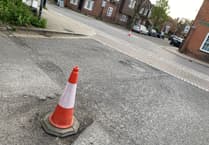There is a long list of eminent scientists with connections to Petersfield throughout the town’s history, writes Petersfield Museum researcher Jeff Brooks.
The scientist John Goodyer was born in 1592 and worked as a Land Agent for estates owned by Magdalen College, Oxford in the Petersfield area.
He and his wife resided at a house, then known as the Great House, in The Spain.
This house is now named Goodyers and there is a plaque commemorating the botanist.
Goodyer’s scientific fieldwork in the South of England led to a number of publications and he identified many plants that were added to the register of British Flora.
He is also credited with introducing the Jerusalem artichoke to English cuisine!
Goodyer died in 1664 and was buried at St Mary’s Church in Buriton.
John Worlidge was born in Petersfield in 1640. Worlidge’s area of expertise was agriculture, including the enclosure of meadows and pastures, watering and drainage systems and the development of machinery to improve yields.
In 1668 Worlidge published Systema Agriculturae, or the Mystery of Husbandry.
He also advocated the consumption of cider rather than wine as its production was more responsive to the British climate. He died in 1700.
The surgeon and anatomist William Cowper was born in Petersfield circa 1666.
He attained membership of the Company of the Barber–Surgeons in 1691 and was elected to the Royal Society in 1696.
Cowper also published a number of physiological, pathological and anatomical works, including The Anatomy of the Humane Bodies, but was accused by some contemporaries of plagiarism.
He is probably best remembered for the first description of the eponymous Couper’s Gland, also known as the bulbourethral gland, in the male reproductive system.
He died in 1709 and was buried at St Peter’s Church in Petersfield.
Thomas Jeeves Horder was born in 1871 and began his medical career at St Bartholomew’s Hospital in London.
Horders clinical speciality was in the treatment of cancer, and also of stomach and heart disease.
He soon made a reputation in his field, especially after treating King Edward VII in the early years of the 20th century.
As a physician went on to attend to an eclectic list of patients including every succeeding monarch (apart from King Edward VIII in his brief reign), Prime Ministers Andrew Bonar Law, James Ramsay MacDonald and Neville Chamberlain, Labour Party leader Hugh Gaitskell and the Woolworths’ heiress Barbara Hutton.
He and his family lived for many years in Steep where he died in 1955.
Archaeologist Stuart Piggott was born in Petersfield in 1910 and educated at Churcher’s College.
He acquired an expertise in Neolithic pottery and is best known for his work on prehistoric Wessex and his five-year study of Butser Hill.
Piggott also authored a number of scientific publications along with the popular introduction to his subject, Approach to Archaeology.
He was President of the Council for Ritual Archaeology from 1967 until 1970 and a trustee of the British Museum from 1968 until 1974. He died in 1996.
Continuing the tradition of scientists with a Petersfield connection today is resident of 20 years, David Wands.
He is Professor of Cosmology at the Institute of Cosmology and Gravitation, in the University of Portsmouth.
His special interest is in the physics of the very early universe and the origin of cosmic structure.




